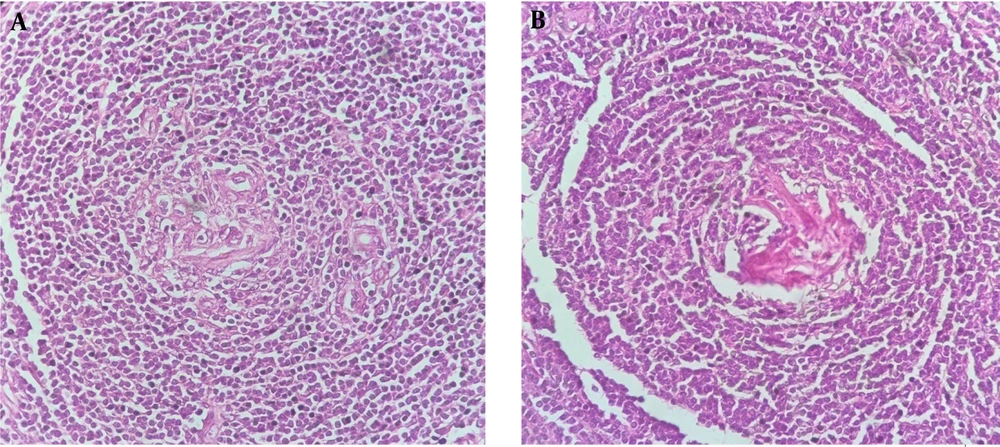1. Introduction
Castleman's disease is a rare nonclonal lymphoproliferative disorder of unknown etiology, classified into subtypes based on clinical and histological manifestations (1). This disease can affect the lymph nodes in any area of the body, most commonly in the chest, but it can also occur in other areas such as the pelvis, neck, and muscles (2). Pathologically, Castleman's disease can be classified as hyaline vascular type (HV-CD), plasma cell type, mixed type, and Castleman disease associated with human herpesvirus (HHV)-8 (3). It typically appears in young adults and is more common in women. Castleman's disease is divided into two clinical subtypes: A localized (unicentric) subtype and a multifocal (multicentric) subtype (4). Surgery is the treatment approach of choice for the localized form, while for the unresectable or disseminated form, partial surgical resection with steroids, chemotherapy, and radiotherapy are treatment options (5). This case report presents an adolescent with unicentric mesenteric Castleman's disease.
2. Case Presentation
A 14-year-old girl came to our center complaining of chronic left flank pain. She had experienced discomfort in the left side of her abdomen for a few days. She reported no nausea, vomiting, weight loss, or fever. The patient mentioned frequent small-volume vaginal bleeding outside her menstrual period. Her vital signs were stable. An abdominal examination was normal, with the abdomen being soft and without tenderness. An ultrasound of the genitourinary system revealed a simple ovarian cyst on the left side but no other pathological findings.
Initial tests showed no abnormalities (WBC = 4.7 (PMN = 2.2, Lymphocyte= 2.0) * 103 /mm3, Hb = 13.4 g/dL, PLT = 193 * 103 /mm3, and CRP was negative). Urinalysis did not reveal any pathological findings, including hematuria. The stool test was negative for WBC, RBC, and parasites, and the fecal occult blood test was negative. The patient was initially treated for several weeks with a possible diagnosis of dysmenorrhea due to the ovarian cyst. However, due to the lack of response to treatment and persistent symptoms, further investigation was conducted.
After careful examination, it was determined that the source of the bleeding was both gastrointestinal and vaginal. A total colonoscopy revealed no pathological findings. Abdominal and pelvic ultrasonography identified a round, hypoechoic, and heterogeneous mass measuring 22 × 35 mm in the left mesentery with regular margins. An MRI of the abdomen and pelvis was then performed, revealing a round mass in the LLQ between the loops of the small intestine, measuring 20 × 25 mm in the lower area of the left kidney border. The mass exhibited comprehensive enhancement and an abnormal signal.
Surgery was performed with a possible diagnosis of GIST. Through open laparotomy, the target mass was removed along with limited lymphatic dissection. In the macroscopic examination, a creamy mass weighing 12 grams and measuring 3.5 × 3 × 2 cm was reported, along with fat tissue that included ten lymph nodes, with the largest measuring 0.5 × 1 cm. The microscopic examination showed a well-defined mass composed of atretic germinal centers traversed by penetrating vessels. The mantle zones were thickened with lymphocytes arranged in an onion-skin appearance, and ten reactive lymph nodes were present. Pathological examination confirmed Castleman's disease of the hyaline-vascular type (Figure 1). The patient was discharged in good general condition with stable vital signs. During follow-up, her abdominal symptoms and bleeding resolved, and no lesions were seen on ultrasonography and CT scans at 6 and 12 months.
3. Discussion
Castleman's disease is a rare member of the heterogeneous group of lymphoproliferative diseases first described by Dr. Benjamin Castleman in 1956 (6). Little is known about the cause of the disease. Still, some accumulating evidence suggests that it is caused by immune dysregulation that leads to the over-proliferation of B lymphocytes and plasma cells in the lymph nodes. These conditions can be triggered by chronic low-grade inflammation, hamartomatous lymphoid hyperplasia, viral infections, abnormal modulation of cytokines, and angiogenesis (7). Castleman's disease is rare, with an incidence of 25 per million patient-years (3). Clinically, it manifests as the more common unicentric (localized or unifocal) Castleman disease (UCD) and the less common multicentric (generalized or multifocal) Castleman disease (MCD) (1, 8).
Our patient had mesenteric unicentric Castleman's disease. However, the most common region of occurrence for unicentric Castleman's disease is reported in the mediastinum (9). Several case reports have described abdominal Castleman's disease in the retroperitoneal area (2, 6, 10). Lv et al. (11) reported a 71-year-old woman with asymptomatic mesenteric Castleman's disease of the hyaline vascular type. Our patient had gastrointestinal bleeding in addition to abdominal pain. Chuwa et al. (12) presented a 28-year-old man with mesenteric Castleman's disease who had low back pain. Su et al. (13) reported a 38-year-old woman with mesenteric Castleman's disease (hyaline vascular type) who had abdominal discomfort. The hyaline vascular type of Castleman's disease predominantly occurs in the chest, and mesenteric hyaline vascular Castleman's disease is very rare (13).
Therefore, our patient had a rare condition due to the occurrence of mesenteric Castleman's disease of the hyaline vascular type, with abdominal pain and lower gastrointestinal bleeding at the age of 14. The patient's symptoms resolved after surgery, and no related findings were observed during follow-up.
3.1. Conclusions
Mesenteric Castleman disease is rare and presents a diagnostic challenge. This disease should be included in the differential diagnosis of abdominal tumors, even in asymptomatic cases. The treatment of choice for unicentric cases is surgery.
